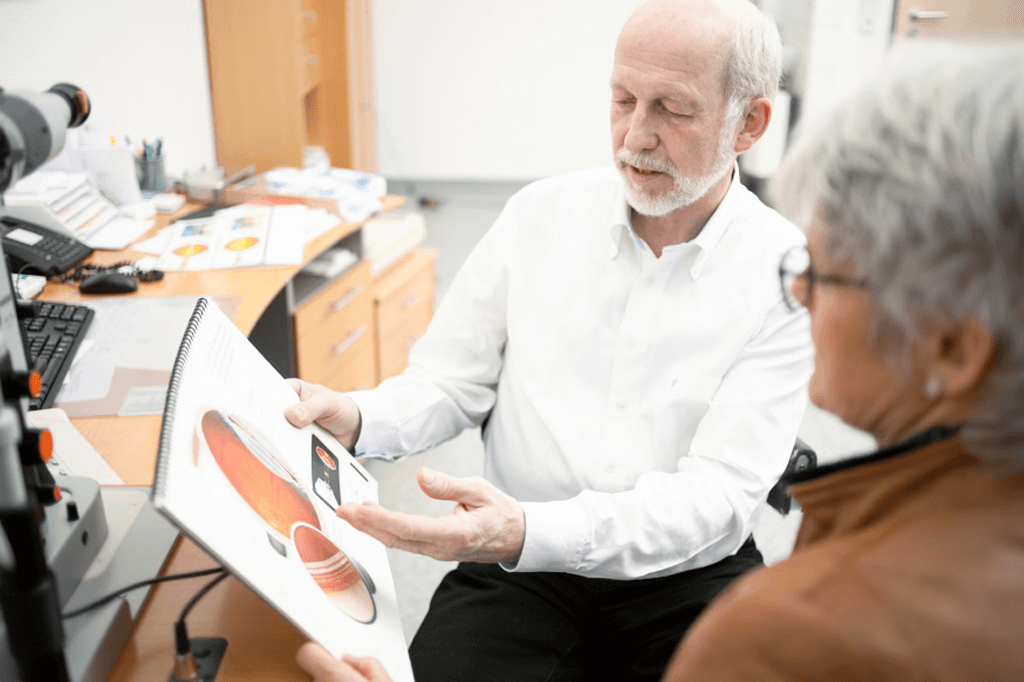
[Photo Credit: www.augencentrumkoeln.de]
Not everyone with glaucoma is excited about having an implant (however small) permanently placed in the eye. Additionally, not everyone with glaucoma has a cataract. Unfortunately, all current FDA approved minimally invasive glaucoma surgery (MIGS) devices are indicated for the treatment of glaucoma only at the time of cataract surgery.
Ab-Interno Canaloplasty (ABiC) may be the ideal micro-invasive glaucoma surgery (MIGS) for those with glaucoma who need surgical treatment but neither have a cataract nor desire to have an implant. Early results (reviewed here) suggest that this short procedure is low risk, can achieve intraocular pressures (IOPs) in the mid-teens, and reduce the number of glaucoma medications used. It is approved for the treatment of glaucoma with or without cataract surgery. Additionally, since canaloplasty has been FDA approved for half a dozen years now, many insurances will cover it (something that is still problematic with the MIGS implants).
Does the IOP-lowering effect of Ab-Interno Canaloplasty last?
But, does the IOP-lowering effect of Ab-Interno Canaloplasty last? That is the question posed by a study recently presented by Dr. Norbert Koerber at the 2017 World Glaucoma Congress. Although small in size (only 25 patients), it was long in duration (up to 24 months of post-surgical follow-up).
Indeed, 64% of the patients who participated in this study were glaucoma medication free after surgery
The average initial IOP of all who participated in the study was 19.5mmHg using 1.7 medications. For those who were followed for the full 24 months the average IOP dropped to 15.7mmHg. Although a two point drop in IOP is far from a “Wow!”, it should be noted that on average the number of medications required to achieve IOP control dropped from 1.7 prior to ABiC to 0.4 24 months out from surgery. Indeed, 64% of the patients who participated in this study were glaucoma medication free after surgery. Given the cost, hassle, and potential side effects of topical glaucoma medications, that is a result worthy of appreciation.
In summary, Ab-Interno Canaloplasty appears to provide a long-term IOP lowering and glaucoma medication reducing benefit to those with mild to moderate glaucoma in need of surgical treatment. Since ABiC can be performed with or without cataract surgery and is covered by Medicare and more insurances than are the MIGS implants, it is also available for a broader range of those with glaucoma who cannot afford to pay out of pocket for surgery.
Related Articles:
- Ab-Interno Canaloplasty (ABiC): A Safe and Effective Glaucoma Treatment
- FDA-Approved Incisional Treatments for Glaucoma – Ab-Interno Canaloplasty
- “Gentler” yet Effective Glaucoma Surgeries
- Ab-Interno Canaloplasty (ABiC) Surgery as a Treatment of Mild to Moderate Glaucoma: 12-Month Results from the University of Oklahoma
- Ab-Interno Canaloplasty: The Most Promising, FDA-Approved, Glaucoma Surgical Treatment?

David Richardson, MD
Medical Director, San Marino Eye
David Richardson, M.D. is recognized as one of the top cataract and glaucoma surgeons in the US and is among an elite group of glaucoma surgeons in the country performing the highly specialized canaloplasty procedure. Morever, Dr. Richardson is one of only a few surgeons in the greater Los Angeles area that performs MicroPulse P3™ "Cyclophotocoagulation" (MP3) glaucoma laser surgery. Dr. Richardson graduated Magna Cum Laude from the University of Southern California and earned his Medical Degree from Harvard Medical School. He completed his ophthalmology residency at the LAC+USC Medical Center/ Doheny Eye Institute. Dr. Richardson is also an Ambassador of Glaucoma Research Foundation.


